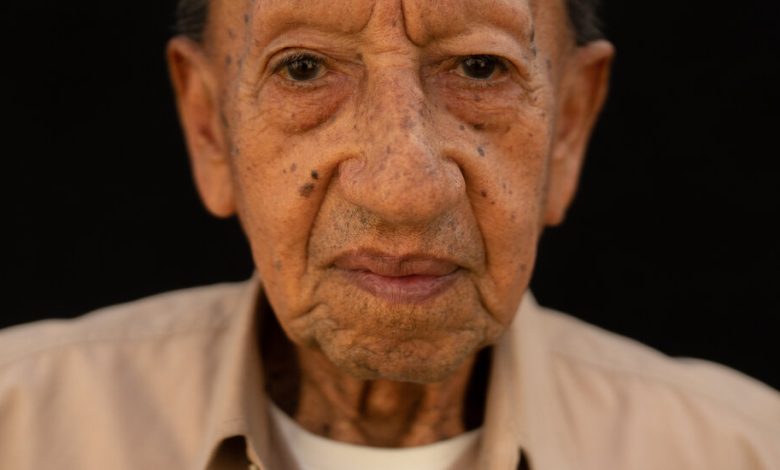This Language Was Long Believed Extinct. Then One Man Spoke Up.

As a boy, Blas Omar Jaime spent many afternoons learning about his ancestors. Over yerba mate and torta fritas, his mother, Ederlinda Miguelina Yelón, passed along the knowledge she had stored in Chaná, a throaty language spoken by barely moving the lips or tongue.
The Chaná are an Indigenous people in Argentina and Uruguay whose lives were intertwined with the mighty Paraná River, the second longest in South America. They revered silence, considered birds their guardians and sang their babies lullabies: Utalá tapey-’é, uá utalá dioi — sleep little one, the sun has gone to sleep.
Ms. Miguelina Yelón urged her son to protect their stories by keeping them secret. So it was not until decades later, recently retired and seeking out people with whom he could chat, that he made a startling discovery: No one else seemed to speak Chaná. Scholars had long considered the language extinct.

Unmute, at lower right, to hear “Sweet Lullaby of a Mother,” a Chaná song.
“I said: ‘I exist. I am here,’” said Mr. Jaime, now 89, sitting in his sparse kitchen on the outskirts of Paraná, a midsize city in the Argentine province of Entre Ríos.
Those words kicked off a journey for Mr. Jaime, who has spent nearly two decades resurrecting Chaná and, in many ways, placing the Indigenous group back on the map. For UNESCO, whose mission includes the preservation of languages, he is a crucial vault of knowledge.
His painstaking work with a linguist has produced a dictionary of roughly 1,000 Chaná words. For people of Indigenous ancestry in Argentina, he is a beacon that has inspired many to connect with their history. And for Argentina, he is part of an important, if still fraught, reckoning over its history of colonization and Indigenous erasure.
“Language is what gives you identity,” Mr. Jaime said. “If someone doesn’t have their language, they’re not a people.”
Along the way, Mr. Jaime has had brushes of celebrity. The subject of several documentaries, he has delivered a TED Talk, lent his face and voice to a coffee brand and has appeared in an educational cartoon about the Chaná. Last year, a recording of him speaking Chaná echoed across downtown Buenos Aires as part of an artist project that sought to honor Argentina’s Indigenous history.
Now, a passing of the guard is underway, to his daughter Evangelina Jaime, who has learned Chaná from her father and is teaching it to others. (How many Chaná remain in Argentina is unclear.)

Evangelina Jaime, Mr. Jaime’s daughter, has learned Chaná from her father and is teaching it to others.
“It’s generations and generations of silence,” said Ms. Jaime, 46. “But we won’t be silent anymore.”
Archaeologists trace the presence of Chaná people back roughly 2,000 years in what is now the Argentine provinces of Buenos Aires, Santa Fe and Entre Rios, as well as parts of present-day Uruguay. The first European record of the Chaná was made in the 16th century by Spanish explorers.
They fished, lived a nomadic life and were skilled clay artisans. With colonization, the Chaná were displaced, their territory shrunk and their numbers dwindled as they assimilated into newly established Argentina, which launched military campaigns to eradicate Indigenous communities and open land for settlement.
Before Mr. Jaime revealed his knowledge of Chaná, the last known record of the language was in 1815, when Dámaso A. Larrañaga, a priest, met three older Chaná men in Uruguay and documented what he learned about the language in two notebooks. Only one of those books survived, containing 70 words.
The trove of information that Mr. Jaime obtained from his mother was far more expansive. Ms. Miguelina Yelón was an adá oyendén — a “woman memory keeper” — someone who traditionally preserved the community’s knowledge.
According to Mr. Jaime, only women were Chaná memory keepers.
“This was a matriarchy,” said Ms. Jaime. “Women were the ones who guided the Chaná people. But something happened — we’re not sure what — that made men take control again. And women agreed to cede that power in exchange for them being the only guardians of that history.”
Ms. Miguelina Yelón did not have any daughters to whom she could pass along her knowledge. (Her three daughters all died as children.) So she turned to Mr. Jaime.
That is how he came to spend his afternoons soaking up stories of the Chaná, learning words that described their world: “atamá” means “river”; “vanatí beáda” is “tree”; “tijuinem” means “god”; “yogüin” is “fire.”
His mother warned him not to share what he knew with anyone. “From the time we were born, we hid our culture, because in those days, you were discriminated against for being aboriginal,” he said.
Decades passed. Mr. Jaime led a varied life, working as a delivery boy, in a publishing house, as a traveling jewelry salesman, in a government transportation department, as a cabdriver and as a Mormon preacher. When he was 71 and retired, he was invited to an Indigenous event, and was nudged out into the crowd to tell his story.
Since then, Mr. Jaime has not stopped talking.
One of the first to publicize him was Daniel Tirso Fiorotto, a journalist who worked for La Nación, a national newspaper.
“I knew that this was a treasure,” said Mr. Fiorotto, who tracked Mr. Jaime down and published his first story in March 2005. “I left there amazed.”
After reading Mr. Fiorotto’s article, Pedro Viegas Barros, a linguist, also met with Mr. Jaime and found a man who clearly had fragments of a language, even if it had eroded with the lack of use.
The meeting marked the start of a yearslong collaboration. Mr. Viegas Barros wrote several papers on the process of trying to recover the language, and he and Mr. Jaime published a dictionary that included legends and Chaná rituals.
According to UNESCO, at least 40 percent of the world’s languages — or more than 2,600 — were under threat of disappearing in 2016 because they were spoken by a relatively small number of people, the latest year for which reliable data is available.
Referring to Mr. Jaime, Serena Heckler, a program specialist at the UNESCO regional office in Montevideo, Uruguay’s capital, said, “We are very aware of the importance of what he’s doing.”
While his work preserving Chaná is not the only case of a language once thought dead suddenly reappearing, it is exceptionally rare, Ms. Heckler said
In Argentina, as in other countries in the Americas, Indigenous people endured systemic repression that contributed to the erosion or disappearance of their languages. In some cases, children were beaten in school for speaking a language other than Spanish, Ms. Heckler said.
Salvaging a language as rare as Chaná is difficult, she added.
“People have to be committed to making it part of their identity,” Ms. Heckler said. “These are completely different grammatical structures, and new ways of thinking.”
That challenge resonates with Ms. Jaime, who has had to overcome entrenched beliefs among the Chaná.
“It was passed down from generation to generation: Don’t cry. Don’t show yourself. Don’t laugh too loudly. Speak quietly. Don’t say anything to anyone,” she said.
For a time, that is how Ms. Jaime also lived.
She shunned her ancestry as a teenager because she was bullied at school and scolded by teachers who doubted her when she said she was Chaná.
After her father started speaking publicly, she helped him organize language classes he offered at a local museum.
In the process, she began learning the language. Now she teaches Chaná online to students around the world — many are academics, though some say they have traces of Indigenous ancestry, with a small number believing they may be descendants of Chaná.
She plans to teach the language to her grown son so he can continue their family’s work.
Back at Mr. Jaime’s kitchen table, the older man wrote his name out in the language he is trying to keep alive. It was a name that he says reflects the way he has lived. “Agó Acoé Inó,” which means “dog without an owner.” His daughter leaned in to make sure he spelled it correctly.
“She knows more than me now,” he said, laughing. “We won’t lose Chaná.”



